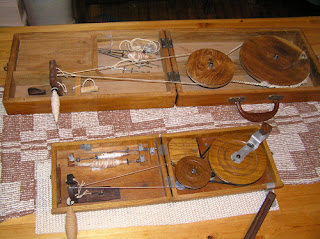I've been planning to spin and weave a set of curtains for my studio window for AGES, and I keep starting and stopping on the project due to the "oooo, shiny!" distraction factor. Some friends who are also Doctor Who (my favorite show!) fans encouraged me to get it going again... it turned into a "dissertation". Now I HAVE to finish, right? RIGHT??
Team: Tardis
Category:
Encyclopedia – C for Charkha
Craft: Spinning
Summary: My plan
is to spin cotton singles on the charkha for the yarn for a future project of
weaving sheer lace curtains for my studio (both the warp yarn and the weft
yarn). I will need 4500 yards of 2-ply yarn, 10/2 weaving weight (34 wpi, 4200
ypp). The charkha will be used to spin the singles only. (I'll ply using the
woolee winder on my electric spinner.) My sample is right on, 34 wpi (shown as
17 wraps per half-inch). I estimate that I’ll need 18 oz of cotton roving to
get my needed yardage (including waste).
The Charkha
The charkha is a small, portable, hand-cranked wheel, ideal
for spinning cotton and other fine, short-staple fibres, though it can be used
to spin other fibres as well. The tip of the charkha spindle reaches faster
speeds than the usual treadle wheel flyer, making it easier to quickly achieve
high amounts of twist. The charkha works
similarly to the great wheel, with a drive wheel being turned by hand, while
the yarn is spun off the tip of the spindle. The floor charkha and the great
wheel closely resemble each other. With both, the spinning must stop in order
to wind the yarn onto the spindle. The tabletop or floor charkha is one of the
oldest known forms of the spinning wheel. The most common type of charkha
available in the U.S. is more strictly identified as the box charkha, in “book”
and “briefcase” or “attache” sizes.
Chiefly responsible for the widespread use of the charkha, Mohandas
K. Gandhi was the preeminent leader of Indian nationalism in British-ruled
India in the early part of the 20th century. Employing non-violent
civil disobedience, Gandhi led India to independence and inspired movements for
civil rights and freedom across the world. Cotton was grown in India where the
men would harvest it and the British would ship this cotton back to England and
have it woven and spun into cloth which was then shipped back to India and sold
at a price that the people could not afford.
In order to resist the British, Gandhi encouraged the men to spin
(traditionally women’s work), weave their own cloth and wear clothing made from
this homespun cloth. This cloth was
called “khaddar” or “khadi” (meaning “rough”). This experiment of Gandhi’s
eventually forced the British to leave India because the men were not
harvesting the cotton, and the use of khaddar cut out the market for the
British made cloth. India eventually gained
economic independence from England. Some
Indian money and stamps have a charkha image, and the Congress Party in India
placed a charkha wheel design on their flag.
Since the traditional charkha was typically bulky and
difficult to move, Gandhi needed a charkha that would be compact, portable and
affordable. Various models of box
charkha were designed and then manufactured. The double-wheel drive, which
allows greater speed and control as well as portability, was Gandhi’s own
innovation.
I’ll be using my Bosworth book charkha. My favourite
position for spinning with the charkha is seated in a chair with the charkha in
my lap. I place a piece of non-slip cloth under the charkha to keep it stable.
Time Justification:
It takes me a solid 2 hours to spin and ply 100 yards of 2-ply yarn this fine.
So I estimate it will take me a minimum of 45 hours to spin and ply this yarn.
Since there are 90 days in this term (Oct. 1st-Dec. 28), I’ll need to spin/ply for an average of 2
hours per day.
Team Tie-In: This
fine white yarn will be used for weaving lace curtains, which will be gauzy and
free-flowing and sheer and translucent, like the bridal veils worn by Amy Pond
and Donna Noble, both companions of The Doctor.
Wish me luck!!!












Debbie, what an excellent post. I took a cotton spinning workshop with Eileen Hallman, thinking I'd never manage charaka spinning but was thrilled at being able to produce yarn. It's a fascinating piece of equipment. And portable!
ReplyDelete